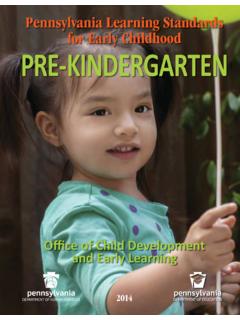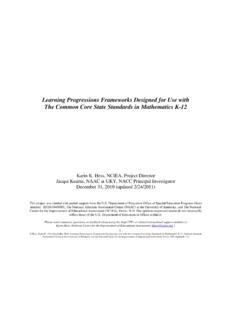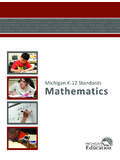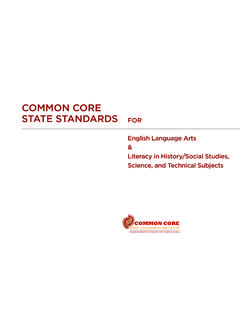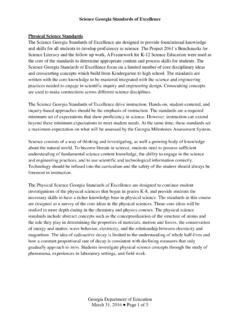Transcription of Mathematics Standards of Learning for Virginia …
1 Mathematics Standards of Learning for Virginia Public Schools February 2009 Grade Six The sixth-grade Standards are a transition from the emphasis placed on whole number arithmetic in the elementary grades to foundations of algebra. The Standards emphasize rational numbers. Students will use ratios to compare data sets; recognize decimals, fractions, and percents as ratios; solve single-step and multistep problems, using rational numbers; and gain a foundation in the understanding of integers. Students will solve linear equations and use algebraic terminology. Students will solve problems involving area, perimeter, and surface area, work with (pi), and focus on the relationships among the properties of quadrilaterals.
2 In addition, students will focus on applications of probability and statistics. While Learning Mathematics , students will be actively engaged, using concrete materials and appropriate technology such as calculators, computers, and spreadsheets. However, facility in the use of technology shall not be regarded as a substitute for a student s understanding of quantitative concepts and relationships or for proficiency in basic computations. Students will also identify real-life applications of the mathematical principles they are Learning and apply these to science and other disciplines they are studying. Mathematics has its own language, and the acquisition of specialized vocabulary and language patterns is crucial to a student s understanding and appreciation of the subject.
3 Students should be encouraged to use correctly the concepts, skills, symbols, and vocabulary identified in the following set of Standards . Problem solving has been integrated throughout the six content strands. The development of problem-solving skills should be a major goal of the Mathematics program at every grade level. Instruction in the process of problem solving will need to be integrated early and continuously into each student s Mathematics education. Students must be helped to develop a wide range of skills and strategies for solving a variety of problem types. Number and Number Sense Focus: Relationships among Fractions, Decimals, and Percents The student will describe and compare data, using ratios, and will use appropriate notations, such as ab , a to b, and a:b.
4 The student will a) investigate and describe fractions, decimals, and percents as ratios; b) identify a given fraction, decimal, or percent from a representation; c) demonstrate equivalent relationships among fractions, decimals, and percents; and d) compare and order fractions, decimals, and percents. The student will a) identify and represent integers; b) order and compare integers; and c) identify and describe absolute value of integers. The student will demonstrate multiple representations of multiplication and division of fractions. The student will investigate and describe concepts of positive exponents and perfect squares.
5 Computation and Estimation Focus: Applications of Operations with Rational Numbers The student will a) multiply and divide fractions and mixed numbers; and b) estimate solutions and then solve single-step and multistep practical problems involving addition, subtraction, multiplication, and division of fractions. Mathematics Standards of Learning for Virginia Public Schools February 2009 The student will solve single-step and multistep practical problems involving addition, subtraction, multiplication, and division of decimals. The student will evaluate whole number numerical expressions, using the order of operations.
6 Measurement Focus: Problem Solving with Area, Perimeter, Volume, and Surface Area The student will make ballpark comparisons between measurements in the Customary System of measurement and measurements in the metric system. The student will a) define (pi) as the ratio of the circumference of a circle to its diameter; b) solve practical problems involving circumference and area of a circle, given the diameter or radius; c) solve practical problems involving area and perimeter; and d) describe and determine the volume and surface area of a rectangular prism. Geometry Focus: Properties and Relationships The student will a) identify the coordinates of a point in a coordinate plane; and b) graph ordered pairs in a coordinate plane.
7 The student will determine congruence of segments, angles, and polygons. The student will describe and identify properties of quadrilaterals. Probability and Statistics Focus: Practical Applications of Statistics The student, given a problem situation, will a) construct circle graphs; b) draw conclusions and make predictions, using circle graphs; and c) compare and contrast graphs that present information from the same data set. The student will a) describe mean as balance point; and b) decide which measure of center is appropriate for a given purpose. The student will a) compare and contrast dependent and independent events; and b) determine probabilities for dependent and independent events.
8 Patterns, Functions, and Algebra Focus: Variable Equations and Properties The student will identify and extend geometric and arithmetic sequences. The student will solve one-step linear equations in one variable involving whole number coefficients and positive rational solutions. The student will investigate and recognize a) the identity properties for addition and multiplication; b) the multiplicative property of zero; and c) the inverse property for multiplication. The student will graph inequalities on a number line.











